- By Marketing
- In Mold Removal
Don’t Let Your Home Make Your Fall Allergies Worse Here’s how to allergy-proof every room in your house in time for fall
Front hall
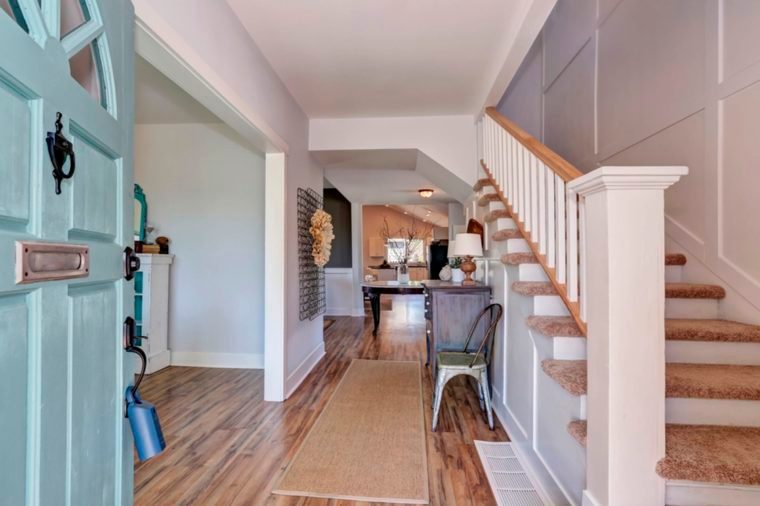 Your hall may be one of the smallest spaces in your home, but it’s where pollen finds its way indoors. Get into the habit of taking off your shoes and outerwear before entering the house, and have both indoor and outdoor mats to wipe your feet. The type of floor in your hallway is also key: As a rule, carpeting is the worst choice for seasonal allergies because the deep pile will trap allergens from dust mites, mold, pollen, pet dander, grass, dirt—and pretty much anything else you have on the soles of your shoes. According to The Allergy Store, laminate and vinyl flooring offer more allergy control than carpeting, and low-VOC options will reduce exposure to chemicals. The best choices are cork or bamboo flooring, as these are resistant to mold and mildew, provide no place for dust mites and other allergens to hide, and are also eco-friendly.
Your hall may be one of the smallest spaces in your home, but it’s where pollen finds its way indoors. Get into the habit of taking off your shoes and outerwear before entering the house, and have both indoor and outdoor mats to wipe your feet. The type of floor in your hallway is also key: As a rule, carpeting is the worst choice for seasonal allergies because the deep pile will trap allergens from dust mites, mold, pollen, pet dander, grass, dirt—and pretty much anything else you have on the soles of your shoes. According to The Allergy Store, laminate and vinyl flooring offer more allergy control than carpeting, and low-VOC options will reduce exposure to chemicals. The best choices are cork or bamboo flooring, as these are resistant to mold and mildew, provide no place for dust mites and other allergens to hide, and are also eco-friendly.
Living room
 Your living room should be a place to relax and spend quality time with your family, not worry about fall allergies. Unfortunately the more comfortable your living room is, the more likely it is to be a haven for dust mites. The mites get into upholstery, cushions, curtains and drapes, laying eggs and leaving droppings and sheddings wherever they set up home. To make cleaning easier, use washable slip covers and cushions and run them through a 130-degree wash once per week, suggest experts at The Allergy Store. All furniture, curtains and drapes should be vacuumed once per week, and keep pets on the floor! Mold can also grow on upholstered furniture, curtains and drapes, so keep the room well ventilated, and deal with any spillages immediately. Did you know that infants exposed to mold in their homehave more than double the risk of developing asthma?
Your living room should be a place to relax and spend quality time with your family, not worry about fall allergies. Unfortunately the more comfortable your living room is, the more likely it is to be a haven for dust mites. The mites get into upholstery, cushions, curtains and drapes, laying eggs and leaving droppings and sheddings wherever they set up home. To make cleaning easier, use washable slip covers and cushions and run them through a 130-degree wash once per week, suggest experts at The Allergy Store. All furniture, curtains and drapes should be vacuumed once per week, and keep pets on the floor! Mold can also grow on upholstered furniture, curtains and drapes, so keep the room well ventilated, and deal with any spillages immediately. Did you know that infants exposed to mold in their homehave more than double the risk of developing asthma?
Kitchen
 Cleanliness is key when it comes to keeping your kitchen allergen-free. If cockroaches get into your kitchen, their droppings and sheddings can trigger an asthma attack. Never leave food or garbage uncovered (use a covered or sealed trash can) and wipe the stovetop and countertops right after cooking and any spillages to remove the food particles that roaches are drawn to. Another possible allergy trigger in the kitchen is mold, as there are so many damp places for it to thrive: under the sink, refrigerator, and dishwasher. Always turn the kitchen fan on when cooking to stop steam and moisture from condensing on surfaces, clean your kitchen floor and floor mats weekly, and keep an eye out for mold. If you do spot mold, remove it immediately and use a mold/mildew spray on the affected area. (While you’re in the kitchen, try cooking with some of these foods to beat hay fever.)
Cleanliness is key when it comes to keeping your kitchen allergen-free. If cockroaches get into your kitchen, their droppings and sheddings can trigger an asthma attack. Never leave food or garbage uncovered (use a covered or sealed trash can) and wipe the stovetop and countertops right after cooking and any spillages to remove the food particles that roaches are drawn to. Another possible allergy trigger in the kitchen is mold, as there are so many damp places for it to thrive: under the sink, refrigerator, and dishwasher. Always turn the kitchen fan on when cooking to stop steam and moisture from condensing on surfaces, clean your kitchen floor and floor mats weekly, and keep an eye out for mold. If you do spot mold, remove it immediately and use a mold/mildew spray on the affected area. (While you’re in the kitchen, try cooking with some of these foods to beat hay fever.)
Bedroom
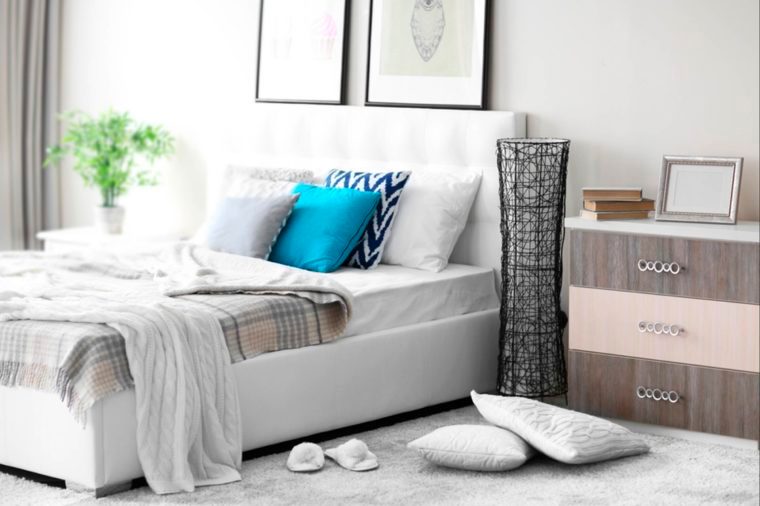 Dust mites, mold and pet dander often set up home in pillows, blankets and mattresses, so it’s important to take care of your bedding and replace it when necessary. Mold in particular is frequently found in mattresses and pillows, and releases spores that can trigger asthma symptoms. The Asthma and Allergy Foundation of America (AAFA) recommends replacing mattresses at least every 10 years and pillows every five years, and investing in mattress and pillow protectors. (This will help you decide if you need a new mattress.) Wash your sheets once a week at 130 degrees to kill dust mites and their eggs, and use bleach when washing to kill mold. If you have pets, never, ever let them onto your bed, as they can transfer mold, dander and pollen from outdoors.
Dust mites, mold and pet dander often set up home in pillows, blankets and mattresses, so it’s important to take care of your bedding and replace it when necessary. Mold in particular is frequently found in mattresses and pillows, and releases spores that can trigger asthma symptoms. The Asthma and Allergy Foundation of America (AAFA) recommends replacing mattresses at least every 10 years and pillows every five years, and investing in mattress and pillow protectors. (This will help you decide if you need a new mattress.) Wash your sheets once a week at 130 degrees to kill dust mites and their eggs, and use bleach when washing to kill mold. If you have pets, never, ever let them onto your bed, as they can transfer mold, dander and pollen from outdoors.
Kids’ room
 Your kids’ room is a breeding ground for allergens—dust mites, mold and pet dander accumulate on toys! The AAFA recommends washing stuffed toys every week in 130-degree hot water—and using bleach if washing to kill mold; placing unwashable stuffed toys in the freezer once a week for 24 hours then rinsing them in cold water will kill and remove mites. Also make sure to keep kids’ toys away from pets. Try storing children’s toys, games and stuffed animals in plastic bins, and have regular decluttering sessions to get rid of the stuff your kids no longer play with. Start your decluttering mission with this list of things to get rid of.
Your kids’ room is a breeding ground for allergens—dust mites, mold and pet dander accumulate on toys! The AAFA recommends washing stuffed toys every week in 130-degree hot water—and using bleach if washing to kill mold; placing unwashable stuffed toys in the freezer once a week for 24 hours then rinsing them in cold water will kill and remove mites. Also make sure to keep kids’ toys away from pets. Try storing children’s toys, games and stuffed animals in plastic bins, and have regular decluttering sessions to get rid of the stuff your kids no longer play with. Start your decluttering mission with this list of things to get rid of.
Bathroom
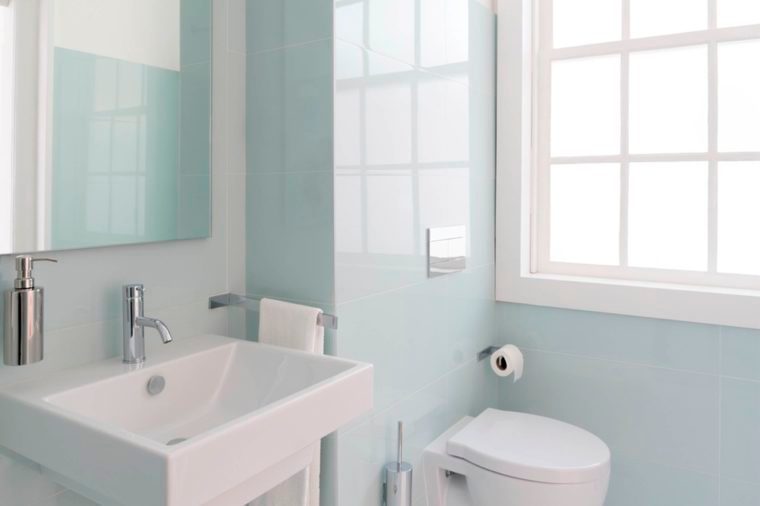 Your warm, damp bathroom is a breeding ground for mold. Start your allergy-proofing with good ventilation. Mayo Clinic suggests installing an exhaust fan to reduce moisture during baths and showers. Decide if your bathroom needs a fall makeover: Instead of carpeting and wallpaper— definite no-nos for allergy control—use tile, vinyl, wood or linoleum flooring, and install tile or paint walls with mold-resistant enamel paint instead. To stop mold from forming, keep as much moisture out of the bathroom as possible. Towel-dry the tub after each use, and use bleach when cleaning the tub, shower, plumbing fixtures, and faucets. Get rid of moldy shower curtains and bathmats immediately, and always attend to leaks. If chemicals trigger your allergies, try natural cleaning products instead.
Your warm, damp bathroom is a breeding ground for mold. Start your allergy-proofing with good ventilation. Mayo Clinic suggests installing an exhaust fan to reduce moisture during baths and showers. Decide if your bathroom needs a fall makeover: Instead of carpeting and wallpaper— definite no-nos for allergy control—use tile, vinyl, wood or linoleum flooring, and install tile or paint walls with mold-resistant enamel paint instead. To stop mold from forming, keep as much moisture out of the bathroom as possible. Towel-dry the tub after each use, and use bleach when cleaning the tub, shower, plumbing fixtures, and faucets. Get rid of moldy shower curtains and bathmats immediately, and always attend to leaks. If chemicals trigger your allergies, try natural cleaning products instead.
Basement
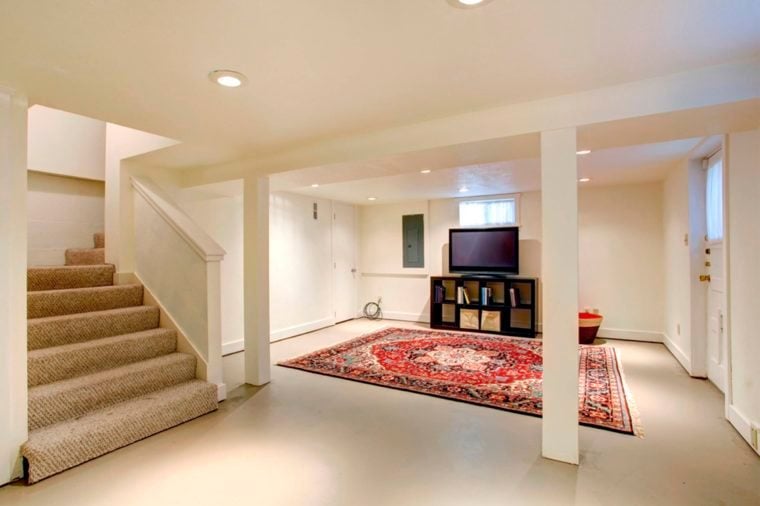 You might not spend as much time in the basement as you do in other rooms of your house, but it shouldn’t be neglected when it comes to allergy-proofing for fall. It’s actually one of the spaces you’re most likely to find a number of potential triggers, such as roaches and rodents who find their way from outdoors (along with their droppings and sheddings), and mold thriving in the dark and damp and releasing allergy-triggering spores. To get rid of allergens from your basement, the AAFA recommends finding and fixing all leaks, seams, and cracks in the foundation (to keep moisture out), fixing leaks and drips in pipes and in and around the water heater and central HVAC system, and carrying out a thorough inspection and removal of mold. If you store items in your basement, do so in plastic storage bins.
You might not spend as much time in the basement as you do in other rooms of your house, but it shouldn’t be neglected when it comes to allergy-proofing for fall. It’s actually one of the spaces you’re most likely to find a number of potential triggers, such as roaches and rodents who find their way from outdoors (along with their droppings and sheddings), and mold thriving in the dark and damp and releasing allergy-triggering spores. To get rid of allergens from your basement, the AAFA recommends finding and fixing all leaks, seams, and cracks in the foundation (to keep moisture out), fixing leaks and drips in pipes and in and around the water heater and central HVAC system, and carrying out a thorough inspection and removal of mold. If you store items in your basement, do so in plastic storage bins.
Every room
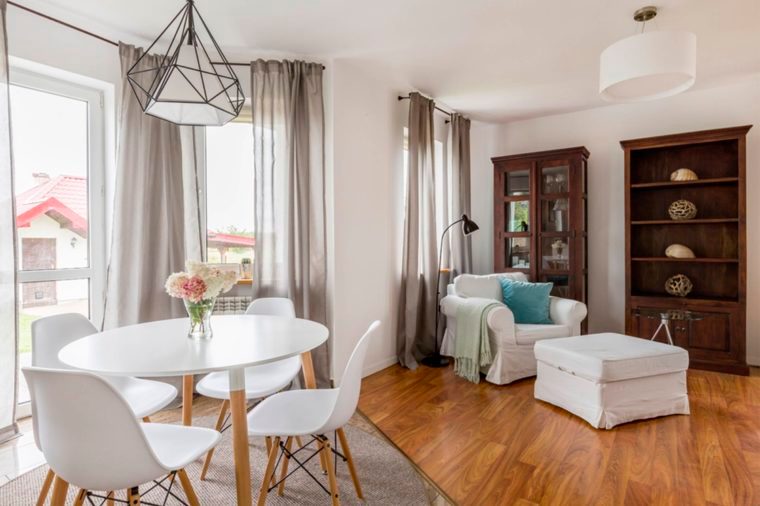 And then there are the allergy-proofing tips that apply to every room in your house: Keep the temperature between 68 degrees F (20 C) and 72 degrees F (22 C), and don’t let the relative humidity rise above 50 percent. Use a de-humidifier to keep mites and mold at bay. The quality of indoor air is also crucial; tiny, light allergens can easily move anywhere around your house. The answer is HEPA (high-efficiency particulate air) filters throughout your entire house central air system, or in-room air cleaning devices. Other tips from the AAFA include wiping and vacuuming all hard and soft surfaces (including window sills and door jams), using a mold and mildew spray to prevent mold growth, keeping all flooring surfaces clean, and vacuuming weekly. If you have pests in any room in your house, use traps from the hardware store or hire a professional exterminator, then seal cracks and other possible entry ways to prevent re-infestation. Finally, think about your lifestyle habits. The AAFA warns that there is a “clear link between secondhand smoke and asthma in children.” If you need help stopping, here are 23 of the best ways to quit smoking for good.
And then there are the allergy-proofing tips that apply to every room in your house: Keep the temperature between 68 degrees F (20 C) and 72 degrees F (22 C), and don’t let the relative humidity rise above 50 percent. Use a de-humidifier to keep mites and mold at bay. The quality of indoor air is also crucial; tiny, light allergens can easily move anywhere around your house. The answer is HEPA (high-efficiency particulate air) filters throughout your entire house central air system, or in-room air cleaning devices. Other tips from the AAFA include wiping and vacuuming all hard and soft surfaces (including window sills and door jams), using a mold and mildew spray to prevent mold growth, keeping all flooring surfaces clean, and vacuuming weekly. If you have pests in any room in your house, use traps from the hardware store or hire a professional exterminator, then seal cracks and other possible entry ways to prevent re-infestation. Finally, think about your lifestyle habits. The AAFA warns that there is a “clear link between secondhand smoke and asthma in children.” If you need help stopping, here are 23 of the best ways to quit smoking for good.
